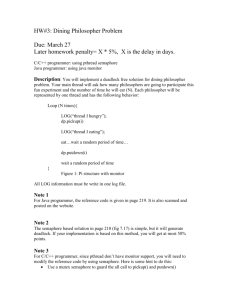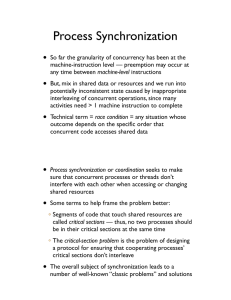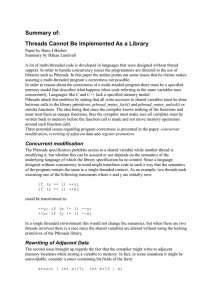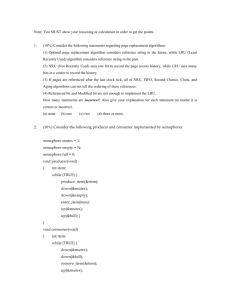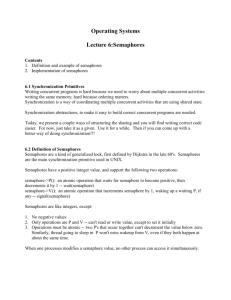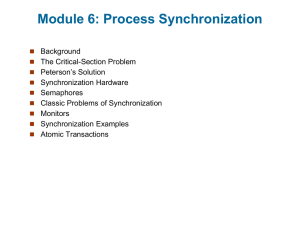Monitors
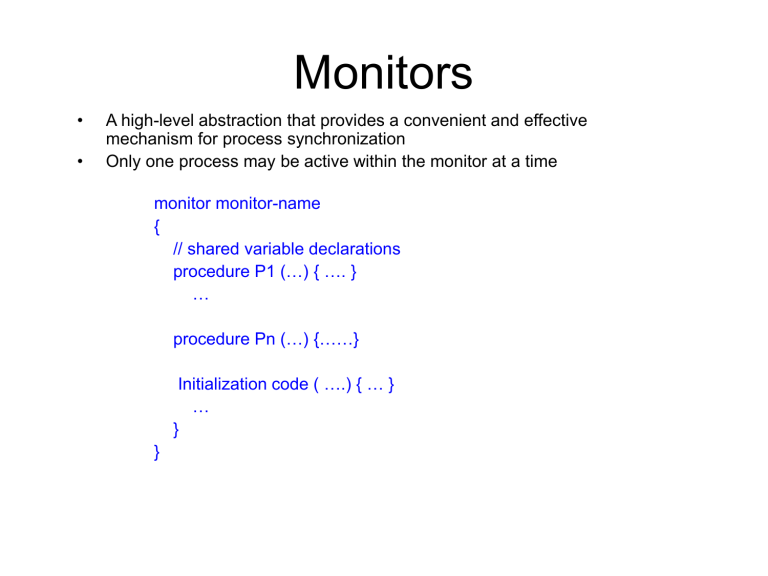
Monitors
• A high-level abstraction that provides a convenient and effective mechanism for process synchronization
•
Only one process may be active within the monitor at a time
{ monitor monitor-name
// shared variable declarations procedure P1 (…) { …. }
… procedure Pn (…) {……}
}
}
Initialization code ( ….) { … }
…
Schematic view of a Monitor
Condition Variables
• condition x, y;
• Two operations on a condition variable:
– x.wait () – a process that invokes the operation is suspended.
– x.signal () – resumes one of processes (if any) that invoked x.wait ()
Monitor with Condition Variables
Solution to Dining Philosophers monitor DP
{ enum { THINKING; HUNGRY, EATING) state [5] ; condition self [5];
} void pickup (int i) { state[i] = HUNGRY; test(i); if (state[i] != EATING) self [i].wait; void putdown (int i) { state[i] = THINKING;
// test left and right neighbors test((i + 4) % 5); test((i + 1) % 5);
}
Solution to Dining Philosophers (cont)
} void test (int i) { if ( (state[(i + 4) % 5] != EATING) &&
(state[i] == HUNGRY) &&
(state[(i + 1) % 5] != EATING) ) { state[i] = EATING ; self[i].signal () ;
}
}
} initialization_code() { for (int i = 0; i < 5; i++) state[i] = THINKING;
Solution to Dining Philosophers (cont)
• Each philosopher I invokes the operations pickup() and putdown() in the following sequence:
DiningPhilosophters.pickup (i);
EAT
DiningPhilosophers.putdown (i);
Monitor Implementation Using Semaphores
• Variables semaphore mutex; // (initially = 1) semaphore next; // (initially = 0) int next-count = 0;
• Each procedure F will be replaced by wait(mutex);
… body of F ;
… if (next_count > 0) signal(next) else signal(mutex);
• Mutual exclusion within a monitor is ensured.
Monitor Implementation
•
For each condition variable x , we have: semaphore x_sem; // (initially = 0) int x-count = 0;
•
The operation x.wait
can be implemented as: x-count++; if (next_count > 0) signal(next); else signal(mutex); wait(x_sem); x-count--;
Monitor Implementation
• The operation x.signal can be implemented as:
} if (x-count > 0) { next_count++; signal(x_sem); wait(next); next_count--;
A Monitor to Allocate Single
Resource
monitor ResourceAllocator
{ boolean busy; condition x; void acquire(int time) { if (busy) x.wait(time); busy = TRUE;
} void release() { busy = FALSE; x.signal();
}
} initialization code() {
} busy = FALSE;
Synchronization Examples
• Solaris
• Windows XP
• Linux
• Pthreads
Solaris Synchronization
• Implements a variety of locks to support multitasking, multithreading (including realtime threads), and multiprocessing
• Uses adaptive mutexes for efficiency when protecting data from short code segments
• Uses condition variables and readers-writers locks when longer sections of code need access to data
• Uses turnstiles to order the list of threads waiting to acquire either an adaptive mutex or reader-writer lock
Windows XP Synchronization
• Uses interrupt masks to protect access to global resources on uniprocessor systems
• Uses spinlocks on multiprocessor systems
• Also provides dispatcher objects which may act as either mutexes and semaphores
• Dispatcher objects may also provide events
– An event acts much like a condition variable
Linux Synchronization
• Linux:
– Prior to kernel Version 2.6, disables interrupts to implement short critical sections
– Version 2.6 and later, fully preemptive
• Linux provides:
– semaphores
– spin locks
Pthreads Synchronization
• Pthreads API is OSindependent
• It provides:
– mutex locks
– condition variables
• Non-portable extensions include:
– read-write locks
– spin locks


